$7.95 (about the cost of a Rum Swizzle)



Summer 2023 Number 39
PICTON CASTLE embarks on a new World Voyage
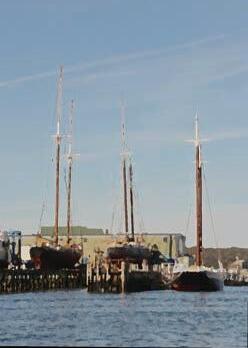
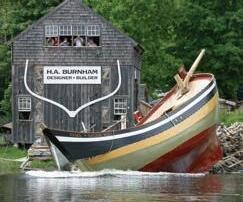

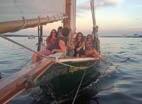
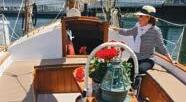

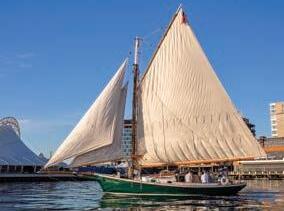
Gloucester Marine RAILWAYS 81 Rocky Neck Ave. Gloucester, MA 01930 gloucestermarinerailways.com (978) 283-2775 “Putting your Vessel on Track” P. O. Box 541 / Essex MA 01929 978.290.7168 * haburnham@gmail.com Indigenous, traditional vessels designed and built to pay for themselves. Our customers are our best sales team: schooner.org in business since 1997 schoonerfame.com in business since 2003 schoonerardelle.com in business since 2011 BURNHAM BOATBUILDING Successful charter business for sale 31’ Jarvis Newman Friendship Sloop (1981) Current COI for 17 guests + Captain & Crew Profitable, Proven Boston Harbor Location $180,000 * (617) 828-9250
Over the years, we’ve written a lot about tall ships and the folks who own and sail them, but not much about the relationship between boat operators and sailors. We’ve tried to encourage a community of traditional sailors, but haven’t written much about the health of that community, or the direction it’s moving in.
In this issue, Noah Waldman of the Bay Lady talks about the community of tall-ship sailors — discovering it for the first time, searching it out in a new place, and trying to build up that community in his new home port of Seattle. Waldman’s goal is to create a business model robust enough to pay decent wages, provide year-round employment, and allow people to forge a long-term career in tall ships.
Is this possible for year-round operators, on large vessels with full accomodations? Often it is, and longer careers are available — at least for those committed enough to develop the skills to become valuable cooks, bosuns, mates, engineers and captains.
Most small for-profit operators, of course, will scoff They barely generate enough income to maintain the boat, pay their bills, and provide a decent living for themselves. Their crews may earn decent money during the season, but once the boat is downrigged, they’re cut loose.
Waldman threw out the idea that boat operators with opposing schedules could share crew. A Maine windjammer could partner with a day-sail operation in Key West. A Great Lakes boat could send their crew to San Diego for the winter, creating steady employment and — who knows? — maybe even some benefits. Meanwhile, both operators benefit from trained and competent crew. Worth a look? Anything that creates a lasting and mutually-profitable community of tall-ship sailors can only help all of us.
MARLINSPIKE MAGAZINE
Summer 2023 • Number 39
Michael Rutstein, Publisher
Marlinspike is published quarterly for $29 by Pennant Publications, Inc., 98 Washington Square #1 Salem, MA 01970
Cover Photo courtesy of Picton Castle
Postmaster: send address changes to Marlinspike 98 Washington Square #1, Salem, MA 01970
Copyright 2023 by Pennant Publications, Inc. All rights reserved.
Phone (978) 594-6510
E-Mail Marlinspike1812@gmail.com
MarlinspikeMagazine.com





4 b Around
Picton Castle has at long last set off on World Voyage 8 14 b Schooning in Seattle A Midwestern sailor finds a home in Elliott Bay 22 b Rendezvous at Le Beau Port Gloucester is celebrating its 400th with, yup, schooners 26 b A Path Less Traveled A former ASTA intern becomes a CG officer and pilot 34 b Once Upon a Ship A brief history of Norway’s STS Sorlandet 40 b Boatyards 44 b Boats, Bars & Beaches 53 b Name That Boat 54 b Show Us Your Spike 55 b Show Us Your Tattoo MarlinspikeMagazine.com 3 MICHAEL RUTSTEIN Community Fair Winds, Michael Rutstein, Publisher
Again
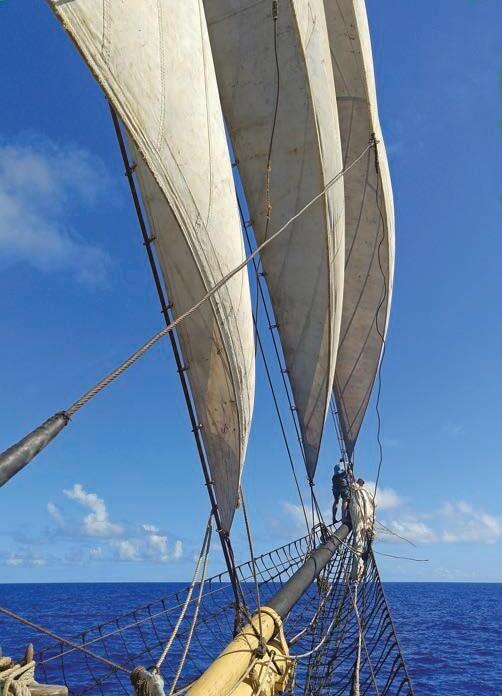
4 MarlinspikeMagazine.com
Around Again
After three years of pandemic-related delays and an unscheduled five-month stint on a broken railway, PICTON CASTLE is once again on her way around the world
On May 10, Picton Castle sailed from her home port of Lunenburg, Nova Scotia on a long-delayed circumnavigation. Less than 200 nm into the voyage, she had to return, due to a medical issue. But after waiting out a few days of bad weather, she finally broke free, and at press time had arrived at the Caribbean island of Anguilla.
We spoke to CEO Maggie Ostler in June, a week after the (second) departure, as she took a break from sweeping up the confetti on the Lunenburg docks.
Marlinspike: First of all — congratulations!
Maggie Ostler: Thank you. To finally have the ship underway again is pretty exciting! All the crew especially are so happy. They really, really stuck with it. They were persistent and tenacious and just hung in there until we could finally get to sea. And they’re a great group. We’re really pleased with the crew that we have on this voyage.
MS: How many of the crew were able to wait out the three years of delays? You must have suffered some turnover, as people’s windows opened and closed for them to be able to participate.
MO: Yes, there was some turnover, but the vast majority of them stuck through all of the delays. The voyage was originally supposed to start in the spring of 2020, so there are folks who have been signed up since 2019 for this voyage! Others had signed on since 2020, and even in the weeks and months leading up to the start of the voyage this spring. We sailed with 40 people on board. And we’re full at 50.
But I should tell you about the day the ship left Lunenburg, because that was incredible. The ship sailed on a Wednesday, the ship was going to leave the wharf at four o ’clock in the afternoon, and we only made the final call about timing on late Tuesday afternoon. So we had less than 24 hours notice.
We’d decided we didn’t want to do a big media push,
but there had been such a buzz about the ship leaving, that we did a social media campaign locally, through our local community bulletin boards and groups and things like that, to let the people of Lunenburg and the surrounding area know that the ship would be sailing and that they were welcome to come down and see her off.
And by four o’clock on Wednesday afternoon, we had probably close to 300 people on the waterfront — maybe more on some of the other wharves that I couldn’t see. We’ ve often had a crowd that big for a homecoming, when the ship comes back from a voyage, but we have never had a crowd that big to send her off. It was really special. I get a little emotional talking about it, actually.
People just wanted to come out and, and show their support for the ship, after such a long time here in Lunenburg, especially after this past winter where we had a number of the crew here and they had the opportunity to get to know folks around town. Many of those people came out to see the ship off and say goodbye to the crew: the staff at the local grocery store, the servers at the pub, and everybody in between.
MS: It was noted, back when Ocean Classroom folded in 2014, that it’s hard for a community and a boat to bond when that boat’s gone for months or years at a stretch. But with Picton Castle home for such an unprecedented long time, you got the opportunity to build those bonds. Just getting used to seeing the boat there, and having the crew around…
MO: The crew bring a vibrancy and an energy to the waterfront. Lunenburg feels it during the summertime. During the season, when the Bluenose II crew are around, you ’re seeing active, vibrant, young people on the waterfront, engaged in the business of the waterfront. Having Picton Castle and her crew here for an extended period of time gave that feeling as well. Having vessel crews, particularly youthful vessel crews, on the waterfront, breathes life into Lunenburg
MarlinspikeMagazine.com 5
“And by four o’clock on Wednesday afternoon, we had probably close to 300 people on the waterfront — maybe more on some of the other wharves that I couldn’t see. We’ve often had a crowd that big for a homecoming, when the ship comes back from a voyage, but we have never had a crowd that big to send her off. It was really special. I get a little emotional talking about it, actually.”
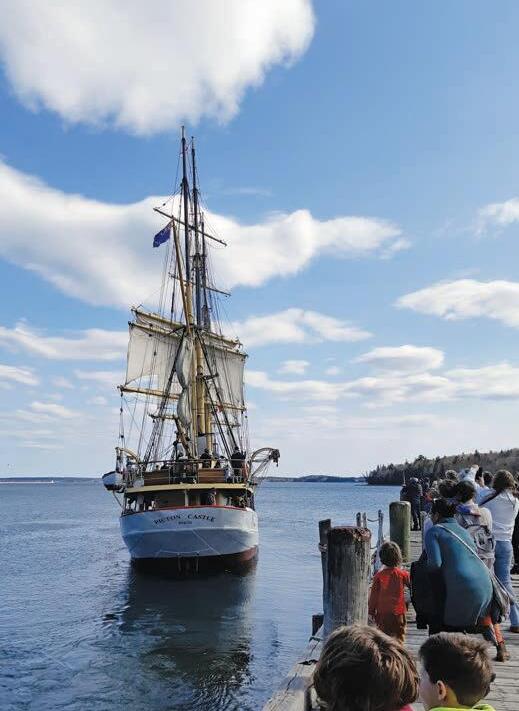 — Maggie Ostler
— Maggie Ostler
6 MarlinspikeMagazine.com
and into the… I don’t want to say the heritage, because that makes it sound like it’s in the past… but the culture of a working waterfront.
MS: After all the pandemic-related delays you had to wade through, the barque was then stuck on a railway for quite some time, no fault of yours. How much did that hold you up?
MO: I think we got hauled out on a Wednesday and we were supposed to be launched the following Tuesday. It’ s one of those marine railways where the cradle is divided in half. It’s quite long. They can launch the whole thing, or they can launch just the bottom half.
So, while Picton Castle was up on the dry dock, they went to launch the bottom half to pick up another ship for a short repair. In the process of launching the bottom half of that cradle, the winch that hauls the cradles up and down broke. That left Picton Castle stuck on the upper half of cradle.
We thought we were going to be there for a week. We ended up being there for five months.
MS: Ouch. Good thing she’s not a wooden boat…
MO: [Laughs] Yeah! Anyway, the hull was in great shape. Within that first week, we had done a couple little steel repairs and a new coat of bottom paint, and the ship was ready to be relaunched. Sitting there for another five months didn’t do any particular damage to the hull, but it was hard on the decks and the rigging.
MS: Did you realize that you would be stuck for a while when the winch broke, or was it like “We think we’ll have it fixed next week”… every week for five months?
MO: We originally were told that it was going to be six to eight weeks. And then it just sort of kept extending from there. Had we known, we would have approached things differently. But it’ s one of those hindsight-is-2020 things.
MS: I guess the good news was: the boat had plenty of time get ready, and the crew know each other better, and have been working together longer, than is normally the case at the outset of a new voyage.
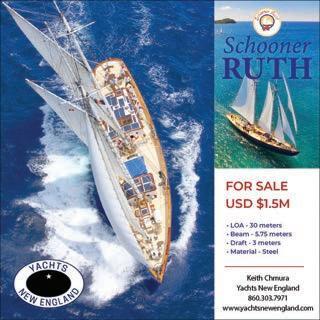
MO: Absolutely! That’s one of the things that I think is going to make this voyage unique, from a crew perspective.
First, there’s the long period of anticipation, all the stops and starts and on-again, off-again that we’ve had… that created this sense of such joy [laughs] at just being able to get underway. People have been looking forward to this for a very, very long time.
When we had the drydock delay, we gave the trainee crew the option either to stay with us here in Nova Scotia, sort of wait it out, or leave for a little while and come back. And many of them stayed. And with the extra time that they spent in Lunenburg, they’re more skilled than a lot of the crew around our previous voyages. We always have a long pre-voyage period here in Lunenburg. That gives the crew a chance to get to know each other, and we have time for training and safety drills and all of that stuff. But these guys got into some of the seamanship stuff that we normally wouldn’t do until the voyage began. So they’re already pretty good at some of the skills that normally people wouldn’t learn until we put to sea.
MS: Picton Castle is getting on in years, for a circumnavigator. What work needed to be done to her for this voyage?
MO: The work that we did in drydock was pretty routine. Almost every time we haul the ship out, we inspect the hull, we gauge the hull thickness. We were pretty pleased with what we found, and anywhere where it was less thick than we would like, we did some sort of repair or addition. But that would have all fit into the week that we were
MarlinspikeMagazine.com 7
scheduled to be out.
I will say that, having the ship sit in Lunenburg without a crew for the duration of the pandemic, there was a lot of work needed to bring her back into service. A lot of that was inspection related. So before we sent the crew up into the rigging for the first time, we did a really thorough rigging inspection, just to make sure that things were in good shape. And then there’s all the coatings and paints and varnish [laughs] and we definitely needed to get some tar in the rig.
Even just now, I had a report that the crew have been working on varnishing the pin rails and the fly rail around the front of the bridge. We needed to take them back down to bare wood and get some fresh varnish on there. A lot of painting and varnishing and tarring and greasing and oiling was required, to get her back into shape.
MS: Last time I checked, they were pretty close to the West Indies. Hopefully they’re getting some good varnishing weather.
MO: They’re actually in Anguilla right now! They arrived Friday [June 2]. It wasn’t part of the itinerary, but we threw in a surprise Caribbean stop for the crew just to give them some tropical blue-water swimming and toes-in-the-
sand before we head for the Panama Canal. Our plan originally was to go straight to Panama and out into the Pacific as soon as we could. But the tropics called [laughs] so we’ve thrown in a little surprise stop for the crew.
MS: Is this route different than the one Dan would have chosen had the boat left earlier?
MO: In terms of the route, it’s very similar. We’ll be hitting all the same island groups, but we will be visiting fewer islands in each group or country. In terms of the distance that we’re covering, the number of nautical miles is about the same, but port stays are a bit shorter. We had planned to go to a number of different islands in French Polynesia, but it looks like we ’re only going to get to a few of them now.
MS: Getting back to the barque herself — how long can she keep going?

MO: [Laughs] That’s a good question! I’m not sure that I’m the right one to answer that question. I feel like Dan would have an answer for that.
MS: Then let me merge those two questions. Dan is getting on in years, for a circumnavigator. What work needed to be done on Dan to get him ready for the voyage?
MO: [Laughs] He is saying that this will be his last long voyage. I think that he will keep going to sea for shorter periods, but I think that this will be his last long one.
MS: And he has family with him on this voyage?
MO: His 10-year-old son is with him, and his wife will be joining them shortly. She’s still in Lunenburg, tying up loose ends.
MS: When Dan says “this is going to be my last long voyage,” he’s kind of leaving the door open there, isn’t he?
MO: I think so, yeah. I mean, for somebody who has spent the majority of his life at sea, I feel like doing anything other than that would be a big shift for him. But at the same time, I think he also feels like he has other things he wants to focus on. Things like the Bosun School, and some other projects as well.
MS: I feel like we were at this same point before COVID, when Dan was talking about how both he and the Picton Castle were going to focus on shorter trips in the
8 MarlinspikeMagazine.com
The crew conducts safety drills at the dock before departing Lunenburg
future.
MO: Yeah, and we have been talking about that for a while. When COVID came, we gave serious thought to what was the right thing for Picton Castle to do. There were so many unknowns about the logistics of international travel, and what would be required in all of the different countries, that we made the decision to go back to what we know best, which is a world voyage. Those are waters we know, that we’re familiar with, the winds and the currents and all that other stuff.
We know what navigating into the ports is going to be. We know what the holding in the anchorage is going to be like. We have contacts in those ports who have become friends of the ship. With so many unknowns, we made the decision to — although a world voyage is never easy, it’s not a small undertaking — to go with what we’re most familiar with.
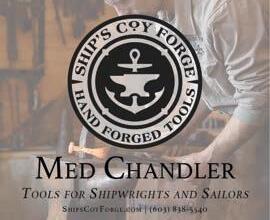
MS: Now that the voyage is well and truly underway, what opportunities are there for people to join? Is there availability on all of the remaining legs?
MO: We are currently full and about to start a waitlist for the second leg, which starts in August and goes until November. That’s from Tahiti to Bali. We do have availability on the third and fourth legs of the voyage. The third leg is Bali to Cape Town, and the fourth leg is Cape Town home to Lunenburg.
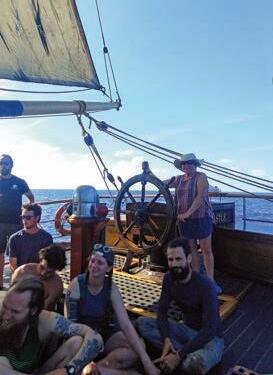
MS: And if people are interested in that, what’s the best way to contact you — through the website or directly?
MO: Through the website, although our website is out of date at the moment, and we’re having technical issues where we can’t update it. So we’re hurrying our way through
getting a new website launched, and that should be ready to go soon.
MS: And it will have a tracker, I hope?
MO: Yes, absolutely. We have a tracker unit on board that pings automatically every eight hours and updates the ship’s position.
MS: What do you do in the office while the ship is out sailing around the world?
MO: People often say, ‘Oh, the ship is gone. You must have nothing to do!’ Not the case at all. We’re working a number of ports ahead of the ship and making all the logistical arrangements, making sure that the ship has a dock or an anchorage to go, that fuel is arranged, provisioning is arranged, all of that stuff. There’s the Panama Canal and all of that. We’re also working with crew who are going to be joining the ship. Right now we’re working on getting the folks who are going to fly to Tahiti in August, ready to sign aboard.
And we’re working on making sure that there are communications coming from the ship that we can
MarlinspikeMagazine.com 9
PICTON CASTLE sailed south from Nova Scotia and arrived at Anguilla in early June
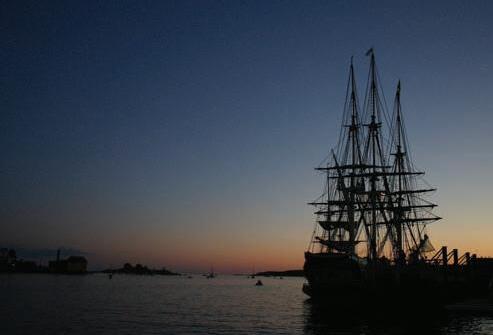



The quarterly magazine devoted to traditional sailing vessels, sailors, and programs! Annual subscription $29 Two years $53 — save $5! For digital subscriptions, visit issuu.com Subscribe via PayPal to Marlinspike1812@gmail.com via credit card by calling (978) 594-6510 or mail your check to: Marlinspike 98 Washington Square #1 / Salem, MA 01970 Visit us on the web at MarlinspikeMagazine.com or have a gam with our 25,000 followers on SUBSCRIBE to MARLINSPIKE
share with folks. We’ve been keeping our captain’s log up to date on our website. Every day the ship is underway, we have a little update — we call them Day’s Runs — that we’ ve been posting on social media and on our website with information about the ship’s location, the weather, how many nautical miles they’ve made in the past 24 hours, all of that stuff.

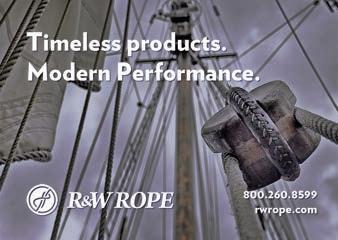
MS: I’ve been following them. When we started the magazine, almost 10 years ago now, Picton Castle was in the midst of a world voyage, and one of the regular features that we hoped to have was Dan’s journal. People really enjoyed that. Of course, communication is so much better now. I assume you can get up-to-date photos and things like that — high-res photos — whereas 10 years ago we used the same damn photos over and over [laughs].
MO: We still struggle a bit in the hi-res photography department. But yeah, communications at sea have come so far. When I started working in the office, we had a system where
we paid per character — for every letter, every period, every comma, every space. Now we can be quite verbose, in text. But sending photographs, that’s still a challenge.
MS: Anguilla is not a big island. I imagine that a barque
MarlinspikeMagazine.com 11
PICTON CASTLE sets some of her 12,000 square feet of sail on the first leg of her voyage
with 40 sailors showing up would blow the doors off their customs office. How do you prepare for an unscheduled stop at a place like that? What does your office need to do to make that happen?
MO: We are fortunate to have friends in a lot of the places that we visit. We actually have a former crew member who’s from Canada, but moved to Anguilla shortly after sailing with us. She and her husband have been super helpful with local arrangements and that kind of stuff, along with a ship’s agent whom we work with at Anguilla. Despite the size of the island, they do get a fair amount of visiting sailing vessels.
One of the nice things about Anguilla is that we get to anchor, so we don’t need to worry about making arrangements to go alongside. And we’ re sending all the paperwork in advance, the crew lists and ship manifests and all that. We’ve had two crew meet the ship in Anguilla as well, so that took a bit of coordination.
The opportunity to support the crew while they do this amazing thing is really rewarding. I’m kind of a nerd, I like
The barque and her crew had an unusually long time to train and prepare for the voyage
the logistical stuff. I always like to know the behind-thescenes of how things happen.
MS: Do you ever wish you were on the barque, and someone else was doing the office work?

MO: Occasionally! [Laughs] I won’t lie about that. But I’ve had my voyage. I did a world voyage as a trainee, and sailed on a part of another world voyage as professional crew. So I know how amazing it is, and I want to give other people the opportunity to experience that for themselves.
MS: Before you go, what can you tell us about the last delay — the medical issue on board that forced the barque back to Nova Scotia?
MO: Picton Castle left Nova Scotia and was not quite 200 nautical miles off the coast when a medical situation developed on board, and pretty quickly, Captain Moreland made the decision to turn around and come back. We got the crew member ashore, to a hospital, and they received medical diagnosis and care. The ship came to anchor; she didn’t come all the way back into Lunenburg. It was quicker, that way, to get this crewmember to a hospital.
The ship came to anchor on a Sunday afternoon, and we knew that there was some unpleasant weather coming through on Tuesday. So Captain Moreland made the decision to stay at anchor through Monday and Tuesday and get under way again on Wednesday.
Meanwhile, the crewmember who needed medical care has just flown down to the Caribbean and rejoined the ship! b
Be sure to check out the barque’s new website and follow her as she transits the Canal and heads through the Pacific!
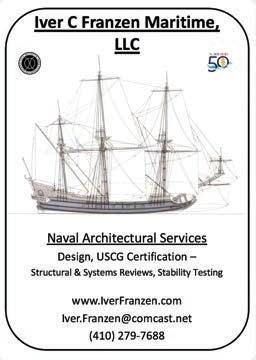
12 MarlinspikeMagazine.com
LETTIE G. HOWARD

 Photo by George Bekris
Photo by George Bekris
Schooning in
Marlinspike chatted with Captain Noah Waldman in June, as his sailing season was beginning. This is the second full season for Waldman and his schooner Bay Lady in Seattle. Bay Lady had formerly sailed out of San Francisco for many years after coming over from the East Coast.
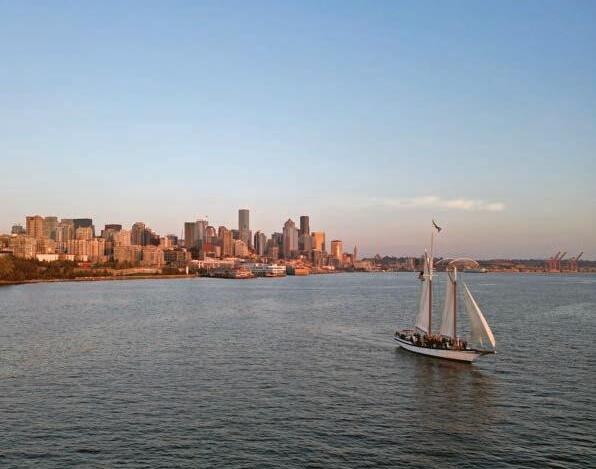
Marlinspike: Noah, tell us how you got roped into this crazy world of ours. I notice you have a Milwaukee phone number!
Noah Waldman: I grew up in the Midwest, grew up in a family of sailors. I was really grateful to have a father who was a boat captain, who really put me on this career trajectory. He ran big ships around the Great Lakes, and he dragged me off to sea when I was a kid. Of course, I was resentful then. But it turned into a career after all my kicking and screaming.
MS: Uh... “resentful”?
NW: Well, I wanted to be at home playing. I was get-
ting pulled off onto these big boats with a bunch of scary sailors. But we did have the dream of building a little sailboat in the garage, when I was like five or six. We built a little stitch-and-glue sailboat. So about the same time that I was learning to ride a bicycle, my father was teaching me to sail on this little boat, and it was just like the most freedom in the world. I could take a bike and ride around the block, or take this little 12-foot sailboat and go on an adventure on the Milwaukee River, and there was nothing like it! I think I’m still kind of chasing the thrill of sailing that little tiny sailboat, even to this day.
MS: What kind of boats was your dad running that were so off-putting to you as a little boy?
NW: He worked on ferries on the Great Lakes, and on dinner-cruise boats. You know, it was always fun when I was out there [laughs], but being a kid is just full of the fear of missing out and wondering what your friends are doing.
MS: When did you start sailing professionally?
14 MarlinspikeMagazine.com
NW: I went to work on the ferries with him when I was in high school. I had a lot of fun doing that, and it paid my way through university. I was studying computer science and finally got an internship as a software engineer. All my guidance counselors said that computer science was the future, that was the big money. And I bought into it. But when I went to do that internship, I just realized immediately that I did not belong in a cubicle. So I had to go back to sea.
I already had the sea time for a captain’s license. So I went and got my masters and decided to head off into the world and make my way as a sailor. I launched a kayak in Chicago and kayaked away from Wisconsin and the Midwest, and figured wherever I ran out of money, I would start a new career!
MS: Literally, you set out in a kayak?
NW: Literally, put a kayak in and paddled as far as New Orleans, where I ran out of money and looked at the job market. I decided I didn’t want to work on the crew boats running out to oil rigs. So I sold the kayak for a bus ticket to Fort Lauderdale, where I went to work on sailing yachts. I had a ton of fun, got a lot of great experience, made a lot of friends… and then the 2008 market collapse happened, and all the boats laid everybody off.
So [laughs] I started working on a sailing catamaran, which eventually led to working out of Key West, where I discovered tall ships.
MS: Key West, that den of iniquity.
NW: Yep. Yep. It’s, uh, [laughs] it’s a great place to
become a sailor. And that’s all I’ll say about Key West. I had so much fun down there.
MS: Which boats did you run on out of Key West?
NW: I worked on the catamaran Echo quite a bit but I also got started sailing with the Western Union, as one of the deck crew…
MS: Those must have been just about the final days for the Western Union.
NW: It was, yeah, one of her last seasons. Such a tragedy. That boat carries such a legacy. I’m sorry to see where the Western Union is today,
MS: You were also doing deliveries on the Appledore II, running back and forth between Key West and Camden.
NW: Yeah, yeah. And that crew is one of the most fun crews that you can possibly be a part of. I fell in love with the community that tall ships brings.
So, a friend of mine in Wisconsin started a tall ship business, bought the Appledore III, and renamed her the Edith Becker. I jumped on his crew to help him deliver it through the Erie Canal out of Gloucester, into the Great Lakes, into Lake Michigan and Sister Bay, where he was starting up that operation. I took on a full-time captain’s position driving the Edith Becker.
That was really my first time as the captain of a schooner, of a tall ship, and I had so much fun doing it. The owner of that operation, Peter Nelson, became an absolute
MarlinspikeMagazine.com 15
n Seattle
A Midwestern sailor has brought the Bay Lady to downtown Seattle in hopes of building his own tall ships community and creating living-wage jobs for tall-ships sailors
mentor to me, and really helped me learn to be a schooner captain, helped me learn to manage a crew, and then eventually encouraged me to start a business,
I spent a season up there, picked up a delivery job moving a catamaran down to Key West, helped the new ownership build a program with their new boat, and got a taste for what it’s like to build an operation from the ground up, which was really exciting and a great experience.
MS: When you say “build a program” you mean, developing a business plan?
NW: Exactly. I hired all the crew, got the boat all set up with the Coast Guard and in her new zone. And we were crushing it, we were doing really well — until we weren’t. We went through some hard times with that program, and since I had hired all of my friends as captains and crew, I wanted to keep them employed and keep them making money.
So I went into a bit of credit-card debt to try and keep that thing afloat. I started taking jobs, doing deliveries while still sending the crew out make whatever we could. But we finally gave up on that operation. And the ownership sold the boat.
MS: How did you get from crushing it to not crushing it? What happened there?
NW: We lost our operating rights at the dock that we were using. We had a really nice, central location, with a hotel, so it was perfect. But then the hotel brought in their own boat.
MS: They saw you crushing it and said, ah ha!
NW: Yeah, yeah. We tried to recover from there and set up a new operation out of Stock Island, but it never thrived in the way that it had before. It was really heartbreaking.
But during that time I took a bunch of delivery jobs and hooked up with the Liberty Fleet of Tall Ships and took over command of the Liberty Clipper, which was a great opportunity, cause we’re operating with a really big crew there. I sailed with the Liberty Fleet until I was able to get out of debt and get my feet back underneath me, and had an amazing time sailing in the Bahamas. Such an amazing opportunity, getting to do the windjammer thing out there, in the tropics!

MS: How did you get from the Liberty Fleet to the opposite side of the country?
NW: Well, I followed a romance, as you do. The romance didn’t work out, but I took a quick shift with the Lady Washington and sailed her up into the Puget Sound. And when I saw the Puget Sound and the nature and the mountains, and met the people up here in the Pacific Northwest, I fell absolutely in love with it and said, I am moving here.
I was still working for Liberty Fleet at the time, going back and forth from Seattle to the Bahamas, when the pandemic happened. I was up in Seattle, and the Liberty Clipper was making a run for Florida, to get out of the Bahamas before everything was totally shut down.
And then I was stuck in my small apartment in Seattle, and I was just looking for my tall ship community, just looking for the local tall ship. I went and I walked the Seattle waterfront, and I was walking next to the aquarium, and I was looking over at the Space Needle, and I was just wondering where our tall ship was. And that’s when I got it in my head that I wanted to build that program here.
MS: Tell us about your acquisition of the Bay Lady
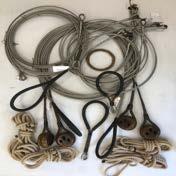
NW: Actually, I built the business plan around another boat. It was basically a motorboat with masts that was down in Oregon. I was never too in love with that boat, but I thought it was a foot in the door.
I was doing some work for a charter company on Lake Union, and I was talking about how cool it would be to bring a tall ship to Seattle. And the guests on the boat worked for the Small Business Administration, and they said, “That sounds like something the SBA would be interested in financing. Why don’t you send your business plan to us?” And within an hour of sending in this business plan, I got a phone call from the
16 MarlinspikeMagazine.com
SOU’WESTER RIGGING, LLC.
SBA and they said, “Let’s build this. Let’s get a tall ship in Seattle. This sounds amazing.”
We kept moving forward with this motorboat down in Oregon, with the masts on it, that kind of looked like a tall ship, but was never gonna be much of a sailor. And then I heard that the Bay Lady had been listed for sale down in San Francisco. My brother lives in Oakland, so I just went to visit my brother and take a tour of the boat and [laughs], she was so cool! Just perfect. And obviously a capable sailor.
When we went for a sea trial, I think we were doing like 13 knots in San Francisco Bay. We had a little bit of current helping us, but we were flying, and the main was reefed, and we were just sailing so hard out there, and it was like, I needed that boat! I went back and revised the business plan for it. The bankers loved it. So, we bought a schooner!
Seven of us went to pick up the boat and we were like, camping, rolling out sleeping bags and hammocks. It was wet and cold, but it was seven days. You can do anything for seven days!
Anyway we sailed it up to Seattle and got all of our certifications and got through all the red tape, but by then it was the end of July. So we missed a big part of 2021, which was a pretty hard start. I was pretty nervous about it. Getting through that winter was hard.
MS: Were there more obstacles, in terms of the Coast
“The cockpit runs the entire length of the boat. It's got seating for 50 in the cockpit alone. Overall it seats about 70, so she does have that enormous COI for 90. But we cap the ticket sales at 65 to make sure that it's comfortable, that everybody has a place to sit, and you can still walk around.”
— Noah Waldman
Guard and certification in your new zone, than you were expecting? Did the Bay Lady have a current COI when you bought her?
NW: Yes, Bay Lady had a current COI. But we had our fixed suppression system discharge, and we couldn’t carry passengers without it. We had to get a new one installed. And with the supply chain in shambles in 2021, it took a month before our new cylinder arrived.
For a while, we were just running free sails. Anyone who wanted to come out for free was welcome, and we just went sailing every day. It was a hard start, and we didn’t have a marketing engine in place. It surprised me how much marketing it takes to make this work.
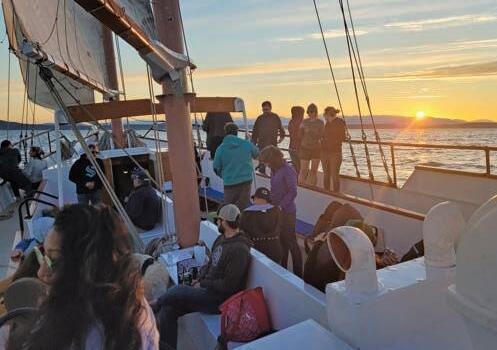
I figured, you bring a big, beautiful boat into a big city and you tie it up to a dock and people see it and say, “I want to go on that.” But that was not the case. We didn’t drive as much traffic as I was expecting.
MS: Tell us a little bit about the Bay Lady
NW: She was actually built in Maine in 1988, for a whale watching program, and she did so well that the ownership went and built a really big boat. So Bay Lady was looking for a new job.
A business in San Francisco picked her up, about the
MarlinspikeMagazine.com 17
“Our summertime weather is amazing. It's perfect. Seattle gets its reputation for rain from the winter months. In late October it gets cloudy and it starts raining and then just keeps raining until April or May. And it's just dark and rainy and cloudy that entire time. But then in May, the sun comes out and it's ideal. It’s 70 to 80 degrees and it's a nice dry heat, so it never feels hot. ”
— Noah Waldman
year 2000, and they put her on a truck. She is an 85-foot schooner [laughs], draws eight feet, she’s 19.5 in the beam. They put her on this enormous truck with like 64 tires and sent her across the country to San Francisco. As the legend goes, the truck driver got halfway across the country, put it in park, and demanded double the money!
They could have taken him to court, but the business in San Francisco wanted the schooner there yesterday, ‘cause it was summertime. So they just paid it. And they ran her down in San Francisco for 20 years, from Pier 80, near the Giants stadium. It sounds like they had an amazing time, and they had a successful business.
But during the pandemic they decided that they had done it. They wanted to downsize and and slow down a little bit, and ease into retirement. So they listed the boat for sale and that’s when I came along.
It was really a product of the pandemic, that all of this came together, having time on my hands and them reevaluating what they wanted to do down in San Francisco. Yeah, the stars kind of lined up to bring the Bay Lady into my life!
MS: Looking at the pictures of her online, she looks very passenger-friendly. She’s got high rails, and bench-type seating. She looks comfortable.
NW: She was purpose-built for the passenger trade, which is really unique. And yes — the railing is one of my favorite features of the boat. With a lot of the operations I’ve been involved with, our guests sat on cabin tops, and there
was just a thin lifeline around the perimeter, and I was nervous the entire time. But Bay Lady has this railing that you can lean against and kids can come aboard, families can bring kids, and I always feel really confident that everyone’s going to be safe.
The cockpit runs the entire length of the boat. It’s got seating for 50 in the cockpit alone. Overall it seats about 70, so she does have that enormous COI for 90 people aboard. But we cap the ticket sales at 65 to make sure that it’s comfortable, that everybody has a place to sit, and you can still walk around. It doesn’t feel like you’re packed together. Even with a group of 65, it still feels really comfortable aboard.
MS: You decided to keep the name, rather than pick something more specific to the Seattle area. Superstition? Laziness?
NW: Right? Well… she has been the Bay Lady her whole life. She sailed in San Francisco Bay and now she sails in Elliott Bay. I’ve played around with changing the name. I wanted to name a schooner after my parents, but “Bay Lady” kind of fits for this boat. I’m keeping it.
MS: You seem to have a good location, right by the Aquarium, near the downtown… but as I recall there are a lot of ferries going in and out.
NW: Elliott Bay is an amazing sailing location for us. The ferry lane is south of us, and we just stay away from it.

18 MarlinspikeMagazine.com
It would open up a little bit more sailing room if we crossed the lane, but then we would have to worry about the ferries, and they are out there moving fast and getting work done! But we’ve got lots of room to sail. There’s surprisingly little traffic in Elliott Bay. If you get around to the lakes in Washington, they’re packed. There isn’t room to set a sail. But the Puget Sound has surprisingly little traffic, especially relative to Key West or Boston Harbor. There’s just nothing but open spaces. Our regular wind direction is northerly in the summertime, so we can just set a course west for Bainbridge Island and sail for eight miles and get up close and cross our fingers that we’ll see some orcas out there.
MS: Yes! I noticed your website mentions seals, sea lions, dolphins and whales. How often do you see them on your sails?
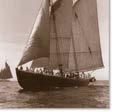

NW: We see porpoises and seals pretty regularly. Orcas, whales, or large dolphins, that’s really rare. Maybe 10 times in six months of sailing last year? It’s always really special when we do see them.
MS: Certainly the skyline and the mountains, it must make for some amazing photos.
NW: It’s unreal. it’s the most beautiful sailing that I’ve seen in all my travels. The Olympic Mountains make for spectacular sunsets. When Mount Rainier is out, it’s just staggering. And then you’ve got the skyline of the city. Everything out here is so big! The city is big. The mountains
are bigger than anything I’ve seen anywhere else. The trees are big. It’s all so big and it really makes for magnificent sailing.
If you say “Seattle” to people, they think rain. So I have to ask: how have you found the weather affects your operations?

NW: [Laughs] Yeah. Our summertime weather is amazing. It’s perfect. Seattle gets its reputation for rain from the winter months. In late October it gets cloudy and it starts raining and then just keeps raining until April or May. And it’s just dark and rainy and cloudy that entire time. But then in May, the sun comes out and it’s ideal. It’s 70 to 80 degrees and it’s a nice dry heat, so it never feels hot. It’s always cooler out on the water and it’s blue skies! I’m gonna knock on wood, but for our summer months are just perfect. We usually have a nice northerly, light in the mornings, but then it picks up in the afternoons. It makes for some really nice sailing.
MS: From a marketing standpoint, having learned your lesson that first season, what have you done to let people know where you are, what you’re doing, what you’re offering? What does your marketing effort look like?
NW: Google Adwords — that’s where it’s at. We’re doing the social media thing too, and paid social media marketing is a powerful tool too. I don’t know what AI’s going to do to this, where the robots just have all the answers, but right now, Google Adwords is where it’s at.
MS: People who are looking for things to do in Seattle, they’re getting out their phone or they’re sitting down at their computer and looking and booking online?
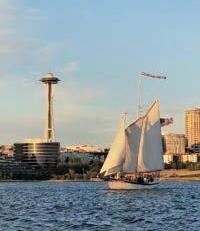
NW: Yeah, I find that most of the bookings are booked well in advance. It’s folks that are still at home in Texas that are buying tickets.
MS: Would you say visitors are the biggest part of your mar-
MarlinspikeMagazine.com 19
ket, or local people?
NW: I’m hoping to increase our reach in the local market here. But we’re driven by tourism.
MS: Do you anticipate building up a charter business to complement your public sails?
NW: Yeah, the public sails are our bread and butter. The corporate events and private events, that’s the cherry on top. This year I was a little nervous, with all the tech layoffs this past winter. That’s a big player in our private events, all these tech companies here. But it looks like they’re continuing doing the team-building events with us. I’m optimistic. We don’t have any educationtype stuff right now. That is a program that I would be excited to build, especially as we get our foundation really solidified here. But at the moment it’s three or four public sails a day, with the occasional private event mixed in there.
MS: I notice you allow infants on board for a dollar. That’s astonishing to me.
NW: Actually, it’s free now. We’re doing infants for free.
MS: You’re a madman [laughs]. Admittedly, the boat I run is not as big as yours. There’s nowhere to go with a screaming infant where it’s not going to impact everyone else on board.
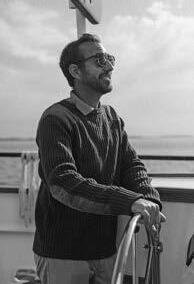
NW: We don’t have many issues with screaming infants. And since we’ve got the space, I want to be the family boat. I want to keep our prices reasonable, so that if a family wants to go sailing, they have the opportunity. I got to go sailing when I was a little kid and I want to make sure that other little kids get to come out sailing, too.
MS: That’s a wonderful sentiment and I honor you for it. Anything else we should talk about, Noah?
NW: A big goal when I started this business was, I felt as though tall ship sailors across the board were abused. I felt like there was opportunity with these programs to create jobs that pay a livable wage and where people can make careers out of being tall ship sailors. And that’s a big goal of mine. I’ve tried to keep that in the forefront of every decision that we make with this program.
I feel so lucky that I was in a place where I had the opportunity to build something like this. And I want to share that with my community.
MS: That is a noble goal, but your boat doesn’t have any berthing accommodations and downtown Seattle is an expensive area to live in. Is this a reachable goal, that you’ve set?
NW: I think we’re doing it right now! We’ve got eight employees right now, and I hope to continue building that, and all of our crew are living in Seattle. So we’re doing it.
MS: What does everybody do on October 31st when you stop running trips?
NW: Last year a good number of ‘em hooked up with Liberty Fleet.
MS: So you’re like Liberty Fleet West.
NW: [Laughs] Yeah. Yeah. And I’m working on some ideas for the offseason. Nothing that I’m gonna pull the trigger on this year, but I’ve got big ambitions to figure out a way that we can continue our season through the winter.
MS: How far down the West Coast do you need to go before you can have a winter season? Los Angeles? San Diego?
NW: I think we’d have to go all the way. Yeah.
MS: I love the idea of partnering up with another boating operation that has an opposite schedule, like you in Seattle and the Liberty Fleet in Nassau. That’s good for the crew — who don’t have go work in a shoe store during the offseason — and good for the operators, who don’t have to find and train new crew every season.
NW: I’m always dreaming that we can make enough money in the summertime that everybody can just go and ski through the winter [laughs].
MS: Yeah. That usually works out for the owners of the boat, but maybe not for the deckhands. ❂
For more info, visit SeattleSailingShip.com
20 MarlinspikeMagazine.com
Capt. Noah Waldman
“A big goal when I started this
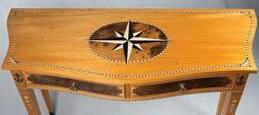

tall ship sailors.”
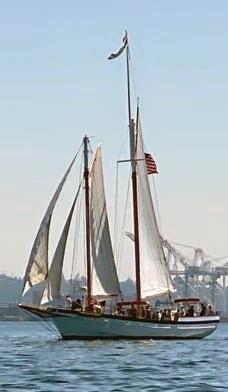
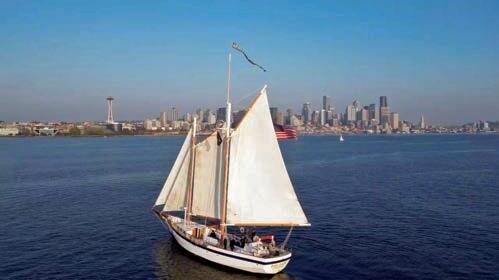 — Noah Waldman
— Noah Waldman
MarlinspikeMagazine.com 21 WickedCreekWoodworks.com Nick@wickedcreekwoodworks.com Custom Woodwork Cabin Interiors and Cabinets Deck Trim * Boxes Coamings and Companionways
business was,
the
there
programs
a livable
I felt as though tall ship sailors across
board were abused. I felt like
was opportunity with these
to create jobs that pay
wage and where people can make careers out of being
A Path Less Taken
When I first found Tall Ships, I saw them as a brief adventure and — an escape from the arid mountains of Utah, where I grew up. Little did I know that Tall Ships and the world of Sail Training would influence my life for the next 16 years!
My journey started in 2006 during my first trip to the Los Angeles Maritime Institute to sail on board the Irving Johnson. Our youth group from Utah spent three days sailing around Catalina Island. We enjoyed it so much that we returned again in 2008 for a four-day voyage. I was hooked!
I would return over the next few summers, volunteering onboard the Irving Johnson and Exy Johnson and taking opportunities to sail on other vessels, like the Europa. After graduating high school, I would sail on the Lynx, Sorlandet, and Oliver Hazard Perry, just to name a few. In 2013, I was a Tall Ships America intern during the Great Lakes Challenge, where I was able to become familiar with many other ships and crews. This new sailing world took me across the globe and gave me the opportunity to travel to Auckland, New Zealand in 2017 and work with the Jubilee
Sailing Trust and SSV Tenacious as their Program Coordinator. Tenacious is unique in that the vessel can be sailed by crew members with various physical disabilities.
After this exciting time in New Zealand, it was time for my next chapter in life.
Before I ever knew what a tall ship was, I saw a Coast Guard MH-65 helicopter fly over a Michigan beach, and thought to myself, “That’s what I want to do.”
I had applied to the Coast Guard Academy out of high school and was not accepted. However, during my time on the USCGC Eagle, I had learned about Officer Candidate School (OCS), and in 2016 I began to work through the application process. I was thankfully selected in July 2020, just before reaching the maximum age of 35.
After being selected for OCS, I started an intensive 17week instruction in leadership and military subjects to prepare me for a career as a Coast Guard Officer. Halfway through OCS, our class took a two-week voyage onboard USCGC Eagle. We sailed from New London, CT to Charleston, SC and back.
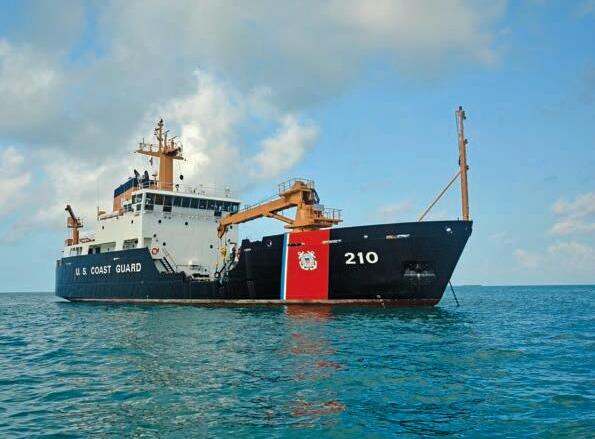
26 MarlinspikeMagazine.com
ALL PHOTOS COURTESY USCG AND BRIAN HOLMEN
Former ASTA intern Brian Holmen has gone from Sail Training to Buoy Tending and now Flight School
“The primary mission set for a seagoing buoy tender is to maintain aids to navigation. Our area of responsibility (AOR) would be from Kodiak Island, west along the Aleutian Islands, and the Bering Sea”.
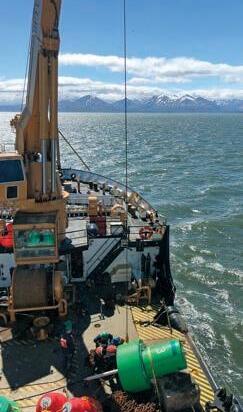

“When approaching a buoy, we would manually drive up, then let the Dynamic Positioning System (DPS) take over once we were on station. DPS is a precarious system, and every attempt had to be made to set DPS up for success when holding station. I had to pay close attention to see what the current and the wind were doing in order to keep all thrusters in balance.”
On one of the night-watches, the mainstaysail was chaffing against one of the shrouds. After watching a crewmember attempt to adjust the sheet, putting herself in danger of falling overboard, I stopped the action, and provided a solution. Since we were motor-sailing, I wasn’t too concerned with the sails driving us forward. They were there simply for stability. My solution was to bring the ship to starboard to depower the staysail, and haul in on the sheet to make it stop chaffing. This effort was successful and a bit of a surprise to some of the crewmembers who didn’t know that I had prior experience on tall ships.
Shortly after the Eagle transit, we were assigned to our first units. I received orders to the USCGC Cypress, a 225’ Juniper-class seagoing buoy tender, which would be homeported in Kodiak, AK. Once we received our assignments, we began more specialized training. In the Coast Guard, there are four main career paths: Afloat, Prevention, Response Ashore, and Aviation. Since I was going to a cutter, I would receive more training suited to the Officer Candidates who were going to the Afloat community. This
MarlinspikeMagazine.com 27
meant maritime simulators, rules of the road, and chart plotting.

Upon commissioning as an ensign, I headed to Alaska. The primary mission set for a seagoing buoy tender is to maintain aids to navigation. Our area of responsibility (AOR) would be from Kodiak Island, west along the Aleutian Islands, and the Bering Sea. As is with any other Coast Guard Cutter, buoy tenders are also capable of conducting Search and Rescue and Maritime Law Enforcement missions, and could be called upon for any other mission at at any time. Since maintaining aids to navigation is the primary mission for a sea-going buoy tender, the Juniper-class cutters look much like the crab boats we commonly saw in Alaska. They have a large buoy deck in the front of the vessel with a crane that can lift up to 40,000 lbs. Aft you have the large superstructure that gives the bridge a clear line of sight onto the buoy deck as well as ahead. There’s one pro-
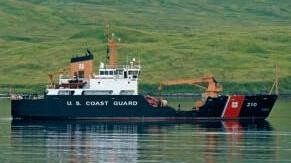
peller shaft powered by two 3,100-horsepower diesel engines. To assist with station-keeping necessary for working buoys, the cutters have a bow thruster and stern thruster. Collectively, all can be controlled through Dynamic Positioning System or manually.
I spent a month familiarizing myself on two 225’ buoy tenders before traveling to Baltimore, MD to move my assigned vessel, CGC Cypress, to her new home in Kodiak. This meant our crew would take CGC Cypress out the Chesapeake Bay, down the coast of Florida, through the Caribbean, and the Panama Canal, and then up the Pacific Coast to Alaska. This is when my tall ship experience came into play.
I’d had several opportunities to conn a Juniper-class buoy tender, but my first real test would be as the Conning Officer through the middle third of the Panama Canal: Gatum Lake to the first set of locks on the Pacific Side. Since we were going through the Canal at night, there wasn’t much to see. However, I was impressed with how well-lit the canal was. We primarily used the day-boards for navigation, looking to our preset track-line for reference. From my experience with Tall Ships, especially in the Great Lakes, the concept of using day-boards was not new to me.
At one time we had to hold position for an hour to let a cargo vessel pass by. Utilizing our main propeller and the bow and stern thrusters, I battled the river current and wind that was coming through the narrow canyon where we held position. While the thrusters made life easier, it reminded me of times I ran around the deck of a tall ship, utilizing the engine and maybe a jib to hold position, or drift in a certain direction. The large superstructure of the Juniper-class buoy tenders creates significant windage that affects maneuvering at slow speeds.
That next summer, CGC Cypress launched into a full operational schedule in the Bering Sea. All the lessons learned in the Panama Canal were put to the test operating in restricted waters to service the numerous buoys in our area of responsibility (AOR).
When approaching a buoy, we would manually drive up, then let the Dynamic Positioning System (DPS) take over once we were on station. DPS is a precarious system, and every attempt had to be made to set DPS up for success when holding station. I had to pay close attention to see what the current and the wind were doing to the cutter in order to keep all thrusters in balance.
30 MarlinspikeMagazine.com
CGC CYPRESS in Alaskan waters
“The Juniper-class cutters look much like the crab boats we commonly saw in Alaska. They have a large buoy deck in the front of the vessel with a crane that can lift up to 40,000 lbs. Aft, you have the large superstructure that gives the bridge a clear line of sight onto the buoy deck as well as ahead. There’s one propeller shaft powered by two 3,100-hp diesel engines. To assist with the station-keeping necessary for working buoys, the cutters have a bow thruster and stern thruster.”

MarlinspikeMagazine.com 31
All of this harkened back to my days on tall ships — especially the few barques that I sailed on — where I learned to balance the forces of each individual sail to make things easier on the helmsman and sail more efficiently. Balancing forces and preplanning equated to time.

Due to the nature of a buoy tenders work, we frequently found ourselves within 50 feet of shoal water. My Commanding Officer onboard CGC Cypress always said that time was one of the most valuable things when working aids to navigation. If we ever lost thrusters or propulsion, we’d have time to react without running aground. The same was true when sailing tall ships. It wasn’t uncommon for me to be woken up early for a watch so we could tack the ship a safe distance from any hazard.
Tall Ships prepared me for many things — conning a vessel, bridge resource management — but while my experience helped when it came to maneuvering, I do wish I had spent more time reading through and understanding the Rules of the Road.
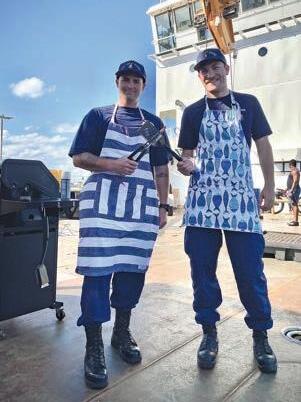
The reality is that Rule 12, which pertains to vessels under sail, is only one rule. It is a rule that the majority of the maritime world doesn’t have to utilize, so they aren’t really concerned about it. During my time getting qualified as a deck-watch officer, Rules of the Road was my weak area. My Commanding Officer (CO) made a remark to me that I usually made the right call when it came to traffic avoidance and risk of collision, but I didn’t know why. He was right!
I didn’t know why I was supposed to alter course to the right in the case of a head-on situation; I just did it because that’s what the captains on tall ships did. A lot of my time on tall ships was going over sail theory, splicing, and knots. All important things to a traditional sailing vessel. However, no tall ship I was on took the time to teach me the Rules of the Road. I encourage sail training organizations to incorporate this, especially if their program is designed to be a stepping stone into the maritime industry. My desire to help people in need, and my comfort with the ocean, made the Coast Guard a great fit for me. After a year and a half, I received orders to flight school in Pensacola. My time on tall ships helped me gain both the technical and leadership experience I needed to get accepted into Officer Candidate School, and during my time aboard the Cypress. Now, as I move into the world of Coast Guard aviation, I have a better appreciation and call to serve all mariners in our coastal waters. Tall Ships was an adventure for me, and the adventure continues with the Coast Guard. Now: to learn the Rules of the Air better than I initially learned the Rules of the Road! ❂
32 MarlinspikeMagazine.com
It’s not all hard work. We hear the grilled seafood is pretty good
Holmen is moving on from buoy tenders. He’ll be fulfilling a lifelong dream when he completes flight school in Pensacola, FL

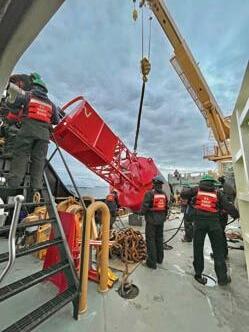

MarlinspikeMagazine.com 33
Once Upon a
A brief history of STS Sørlandet
By Nadia Dale
On March 31st, 1854, in Egersund, a small town on the southwest coast of Norway, Oluf Andreas Tollefsen Skjelbred was born. Not much is known or remembered about his early years, but by the time he reached the age of 16, he had lost both of his parents.
The orphan was shipped off to sea. As a cadet on a traditional sailing vessel, he learned the art of seafaring. One might imagine the positive effect joining a crew could have on a young man, grieving and alone in the world. As a trainee, he was part of something greater than himself. He was an essential cog in a vital machine – the ship’s crew. He and his shipmates formed tight bonds as they depended on one another to keep the sails full, the ship on course and everyone on board safe.


This experience, coming soon after the death of his parents, must have had a profound impact on the young man. Indeed, his becoming a sailor was synonymous with his becoming a man. In the years that followed, he dedicated his career to seafaring, and worked his way up in the Norwegian merchant fleet until he reached the rank of Master.
In the early twentieth century, Norway’s merchant fleet was rapidly expanding. While Germany and England were
34 MarlinspikeMagazine.com
Ship



building steamships at an alarming rate, Norway continued to use sailing vessels for transporting goods. With strong seamanship, using free wind power, and with more room for cargo without having to fill bunkers with coal, the Norwegians could remain competitive.

Captain Skjelbred was part of this expansion. At the time, it was common for ship captains to own shares of their vessels. Eventually, Skjelbred bought up all the shares of his ship, then of another. The young entrepreneur was soon hiring others to crew his vessels and settled into a more comfortable life as a shipowner.
By this time, Skjelbred was living with his wife and children in Kristiansand, the largest urban centre in the south of Norway. He had his own company, Skjelbreds Rederi, which included a modest fleet. Now a wealthy man, and with a desire to give back to the sailing community, he turned to philanthropy.
Skjelbred still valued traditional seamanship on board vessels of all types, and felt there was a need for a school ship to educate young sailors. A training ship would allow prospective sailors the opportunity to learn traditional seamanship skills in a practical environment. In addition, he started a land-based school that would act as part of the seaman’s training pro-
 PHOTO: A+ WORLD ACADEMY
PHOTO: A+ WORLD ACADEMY
MarlinspikeMagazine.com 35


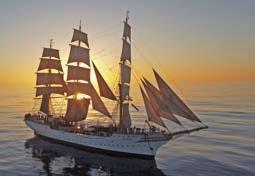

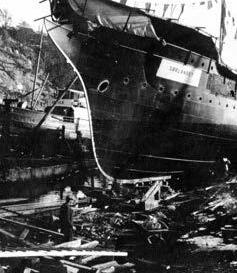

36 MarlinspikeMagazine.com
PHOTO: A+ WORLD ACADEMY
PHOTO: JEN SPRING
gram. The school still exists to this day.
Skjelbred commissioned a 210-foot, three-masted steel square-rigger to be built at the Høyvold Shipyard in Kristiansand. Skjelbred set up a board of maritime experts, found a suitable manager to run the school, and stepped back to watch his project bloom. Construction began in 1925 and was completed on May 28, 1927. They christened the new ship Sørlandet, meaning “south land” after the place she was built.
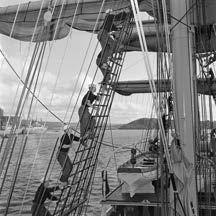
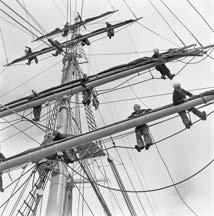
The Sørlandet departed Kristiansand on her maiden voyage to Oslo, where she was inspected by King Haakon and Crown Prince Olav, both of whose portraits are displayed in the aft ship’s salon. Later that year, she sailed to London with approximately 90 trainees on board. It was the beginning of a long history of educating young sailors.
In 1933, the Sørlandet crossed the Atlantic for the first time. The crew sailed her to Chicago for the World’s Fair celebrating ‘A Century of Progress’. When being towed into port (the Sørlandet still did not have an engine at that time), the ship collided with another vessel. The incident made the local news, but was less of a story than the arrival of the great ship herself. *
I have been fortunate enough to sail on board the Sørlandet on four separate occasions totalling fifteen months. The first as a trainee, then a volunteer deckhand, and later as galley crew. In other words, to me, the ship is home.

During my second summer as a Cook’s Mate, we welcomed an elderly man and his grandson on board in Kristiansand. We were told they were important guests. After a few days, I learned that Kristian was, in fact, Skjelbred’s
great-grandson.
Kristian, now in his eighties, does not remember much about his great-grandfather, who died in 1939, when Kristian was only three. Perhaps this was lucky, as weeks later, Germany invaded Poland and Europe was at war. Skjelbred never saw what became of his beautiful ship during those dark years.
Before the war broke out, Kristian had a comfortable childhood. His family was well-off, thanks to his great-grandfather's shipping company. But in the spring of 1940, Norway was occupied by German troops. To this day, Kristian clearly remembers the night his father was taken away.
When the Gestapo arrived at their home, everyone was asleep. He recalls seeing a group of strangers in their leather jackets, flanked by soldiers and steel helmets with rifles at their sides, and accompanied by a Norwegian interpreter. Coincidentally, the interpreter was a family friend, but that did not stop the Gestapo taking his father away. Once the men left, Kristian remembers crawling into bed with his siblings and mother and waiting for sleep to come.
Under Nazi occupation, the Sørlandet was confiscated by the German Navy and used as accommodation for U-boat flotillas at the German naval base in Kirkenes, situated in northeastern Norway, close to the Finnish and Russian borders. During those years, Kristian never set eyes on the ship.
In June of 1941, the Germans attacked Russia. At the same time, they simultaneously opened a Northern front through Norway and Finland. As a result, Kirkenes was extensively bombed — the Sørlandet included — and she sank in the harbour. For several years she lay on the bottom, forgotten in the chaos of war.
MarlinspikeMagazine.com 37
In 1944, the Germans raised her, patched her up and towed her back to Kristiansand to be used once again as accommodation for visiting U-boats. When the war finally came to an end in 1945, the Germans evacuated Norway, and the Norwegians were left to rebuild.
After being used and abused in her war years, the ship was in critical condition. Her masts, rigging and bowsprit were gone, and she was in need of extensive repairs.


Her eventual restoration was funded by the Norwegian War Insurance as well as by war reparations from Germany. The restoration was completed at the same Høyvold Shipyard where the ship was originally built. Once restored, she was again used as a training ship to educate seamen in Norway’s merchant fleet under the management of
Kristian’s grandfather, Skjelbred’s son. Later, leadership was passed to Kristian’s uncle.




In the summer of 1954, Kristian sailed on board as a cadet for the summer.


A few years later, an engine was installed, and she was no longer exclusively a sailing vessel.
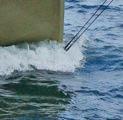


By 1974, her days as a training ship seemed numbered. There was, it seemed, no longer any need to train sailors in traditional seamanship. Learning to hoist sails, to brace the yards, to tack or wear, were no longer skills required to be a modern mariner, although it was certainly character-building. Even back when the Sørlandet was built in 1927, she would have been considered outdated, so this waning interest in traditional sailing was not entirely unexpected. The decision was made to sell the ship to a man named Jan Staubo, and she was laid up for several years. Financial troubles in 1977 led to the ship being put up for auction.
Now head of SkjelbredKnudsen family and CEO of Skjelbreds Rederi, Kristian felt obligated to buy back the ship and restore her to her former glory. He struck a deal with the town of Kristiansand: he would gift the ship to the town, provided the town agreed to keep her running and seaworthy alongside in Kristiansand with a skeleton crew. Beyond that, any voyages or commitments the ship took on would have to pay for themselves. In other words, the ship had to generate its own income.
In 1981 Kristian set up a nonprofit, with a board of directors who would steer the ship on a successful course. The Fullriggeren Sørlandet Foundation was born and continues to do great work. Once again, the ship’s mission was sail training, but this time women would be allowed become trainees, making the Sørlandet the first sail training program to include women. A small, locking cabin with six bunks was built on the port side of the banjer, nicknamed the ‘virgin nest.’
The years passed, and the Sørlandet Foundation found it needed to reinvent itself once again. In 2010, the ship was chartered by a Canadian high school program called Class Afloat. Cue my arrival


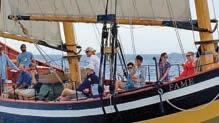



38
MarlinspikeMagazine.com
d ichm .com d@ allenif mond ENDORSED (8 | om/tallships . c llenIF A 439-4311 800)
at Kai 6, the ship’s home pier, with my canvas sail bag stuffed to breaking point.
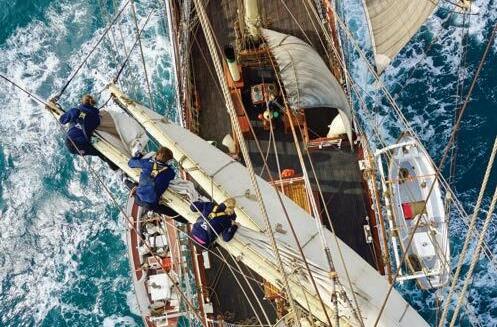

Early on in my voyage as a trainee, we were all called to gather in the banjer one evening to hear the captain share the history of the ship. I remember sitting in the cramped room, slightly sweaty from so many warm bodies, listening with rapt attention. The Sørlandet’s story is a turbulent one, full of financial woes, battle scars and changes in ownership. The ship was built, loved, abused, sunk, dredged up, restored, refitted, refitted and refitted again. She has been sailing for nearly 100 years now, and remains the oldest fully-rigged square-rigger in operation. Today she is home to her very own sailing and boarding school, A+ World Academy.

After all these years, I am still daydreaming about my time on board, still writing about it. Every so often, I catch myself checking her position on AIS instead of sending emails at work. Sailing aboard the Sørlandet had a profound impact on my life. I left a part of myself on that ship, and I could not be prouder to have been, even for the briefest of periods, a guardian and caretaker of Skjelbred’s legacy. ❂
Nadia Dale is a writer and teacher based in Vancouver, BC. She holds an MFA in creative nonfiction from King's College Halifax and is currently working on a memoir about her time spent living among sailors aboard the Norwegian tall ship Sørlandet.
MarlinspikeMagazine.com 39 Authentic Tarred Hemp Marline American Rope & Tar 8115 River Front Ln. Fair Oaks, CA 95628 (877) 965-1800 www.tarsmell.com
Work continues on the schooner Hindu in Thomaston Maine.
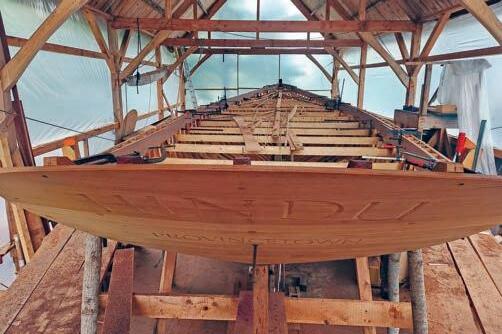
“At last the framing is entirely done! A new teak and iroco transom has been hung, and the clamp is started,” weites Erin Desmond.
“The original iron keel has been sandblasted and refinished to go back under the Hindu. The purple heart keelson, spanning over 2/3 of the new black locust frames, has been steamed so that the shoe can get bolted into place without any gaps. Over the summer, planking will begin.
“The goal is to launch the Hindu in June of 2024, which means this last year will be a hustle!”
In the meantime, Josh Rowan and Erin Desmond have started a new non-profit to help sustain the Hindu through this rebuild and over the next century. Check it out here: www.sailasyouare.org
Harold Burnham writes from Essex:
“It has been another busy spring here at Burnham Boat Building. Since mid-April, all of our efforts have been on our own projects. We got a lot of rotten wood removed from the Sylvina W. Beal in preparation for hauling. In fact,we got her under way for the first time in a couple of years, if only just
to move her up the creek a bit.
“Before we go too much further on her, in accordance with our preservation plan, we will be re-lofting the vessel in preparation for renewing most of her structure.

“Beyond our work on the Beal, we put a lot of work into Ardelle’s maintenance, putting her in the best shape she has ever been in. Since May 14, we have taken almost 1,000 school kids sailing in addition to our regular public sails and private charters.
“Between these trips we have also been getting Isabella ready for what will be her first season as a Passenger Fisherman out of Gloucester, Massachusetts. Among all the other details, this includes a new set of standing rigging built by Sou’wester Rigging (see their ad, page 16) which we could not be happier with.” H
“Virginia spent a safe winter in Wiscasset Harbor on the Sheepscot River,” writes Allison Hepler of Maine’s First Ship. “It’s an ice-free river, unlike her home port, the Kennebec River in Bath. Volunteers continued to work through the winter on the focsle.
“On May 19, she made a successful transit down the Sheepscot, around Bay Point, into the mouth of the

H
40 MarlinspikeMagazine.com HINDU
Kennebec and up river to Bath, where’s she temporarily berthed at the Maine Maritime Museum while the MFS dock undergoes a wharf repair. The juxtaposition of Virginia against the backdrop of Bath Iron Works is notable.
“The riggers are continuing on where they left off last fall. The lower standing rigging is mostly set up and rattled down and they are experimenting with the best ways to raise and control the big sprit yard that will spread the sprit mainsail. Topmast rigging will be going up shortly after.
“As Virginia becomes a sailing ship, she’ll require hands to sail her. To that end, we’re starting initial crew training, open to our volunteers and anyone else interested in learning how to sail this unique vessel, and able to commit to taking part in some of our planned summer transits.
“Also this summer, MFS has a full schedule of workshops, lectures, and field trips as Virginia visits Colonial Pemaquid, Boothbay Harbor’s Windjammer Days, and Popham Flare Night.”
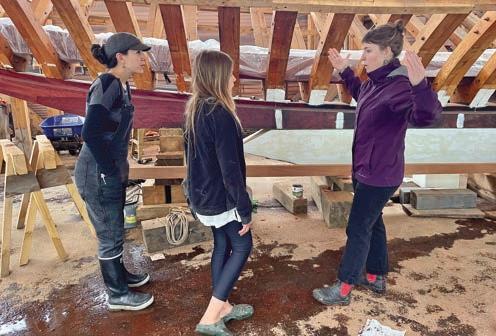
At the Jungle Shipyard in Costa Rica, Ceiba continues to take shape.
“Last week we started a new step in Ceiba’s structural construction. The hanging knees will brace vertically between the frames and the deck beams. Easy to be confused with the deck knees that reinforce against horizontal (side to side) movement between the deck joins, these larger knees will hang in the top corners of the cargo holds, preventing
the ship from twisting or warping under the strains of ocean waves.
“These pieces of wood were carefully chosen to have grains that curve and aid the strength of the shape and have been drying in the yard since. The team have to plane them down to size for each location before fixing them into place.
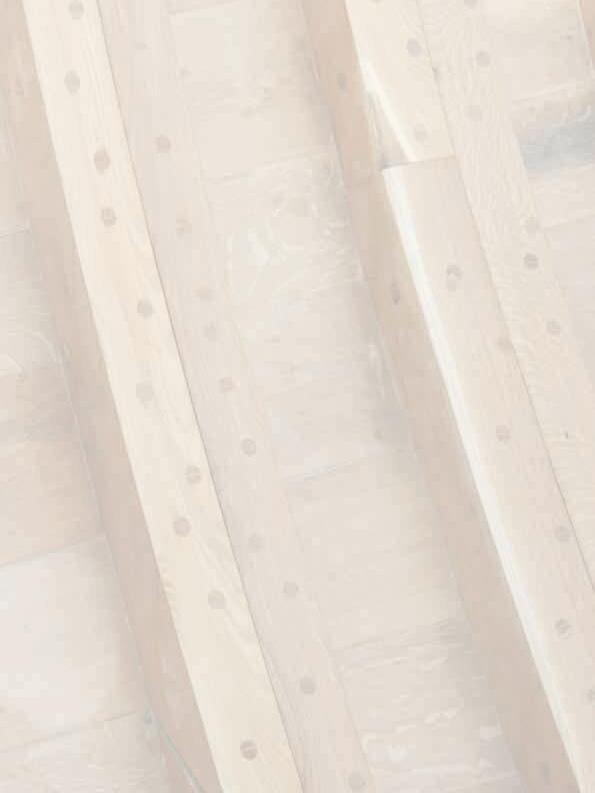
“Sailcargo Inc’s mission is to build and operate a fleet of sailing cargo ships. We want to prove that there is sufficient demand for zero-emission cargo shipping by offering competitive solutions for clean shipping. We are entirely funded by private investors who want to be part of the clean shipping movement. Learn more at www.sailcargo.inc”
H
Maryland Dove, launched last August, will be visiting Fells Point in Baltimore June 20-22, thanks to a grant from the Maryland Heritage Areas Authority and matching funds from Historic St. Mary’s City Foundation.
The Dove will also be visiting Havre de Grace, MD June 24 & 25, and Cambridge, MD on June 30-July 1.
The state-funded ship was built at the Chesapeake Bay Maritime Museum. All work was done in full public view, allowing the public to experience every stage of the project.
In general, the Dove can be found docked in Historic St. Mary’s City. The ship is available for viewing Tuesday–Saturday in the spring, Wednesday–Sunday in the summer, and Tuesday–Saturday in the fall. b
Got an update for Boatyards? E-mail us!
H
MarlinspikeMagazine.com 41 HINDU
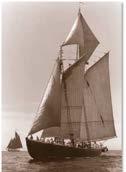
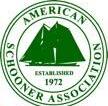
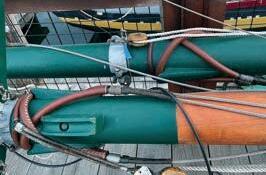
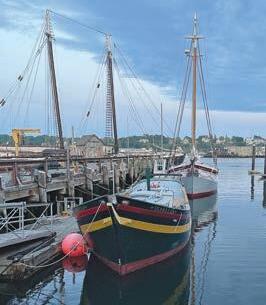

ISABELLA ISABELLA ISABELLA, ARDELLE, ADVENTURE 42 MarlinspikeMagazine.com
A select list of sailing opportunities open to the public.
WEST COAST
Call of the Sea, Sausalito, CA (415) 331-3214 * CalloftheSea.org
Education programs aboard Seaward and Matthew Turner. Grays Harbor Historic Seaport, Aberdeen, WA (800) 200-5239 * HistoricalSeaport.org
Sailing aboard the brig Lady Washington. Los Angeles Maritime Institute, Los Angeles, CA (310) 883-6055 * LAMITopSail.org
Sail-training for school and youth groups. Maritime Museum of San Diego, San Diego, CA (619) 234-9153 * SDMaritime.org
Day sails on Californian and the galleon San Salvador. Ocean Institute, Dana Point, CA (949) 496-2274 * OceanInstitute.org
Marine science and ed programs; operators of Spirit of Dana Point. SALTS, Victoria, BC (888) 383-6811 * Salts.ca
Sail training for youth, day sails for all, on two large schooners Schooner Adventuress, Port Townsend, WA (360) 379-0438 * SoundExp.org
Overnight programs for teens, adults, seniors, and families. Schooner Zodiac, Bellingham, WA (206) 719-7622 * SchoonerZodiac.com
Windjammer cruises in the San Juan Islands, April-October. Schooners North, Friday Harbor, WA (360) 378-2224 * SanJuanSailCharter.com
Cruises from the San Juans to Alaska on the schooner Spike Africa.
GREAT LAKES
Appledore Tall Ships, Bay City, MI (989) 895-5193 * BaySailBayCity.org
Day-sails, charters, ed programs, and overnight opportunities. Brigantine St. Lawrence II, Kingston, ON (613) 544-5175 * Brigantine.ca
Sail-training programs on the St. Lawrence and Lake Ontario. Traverse Tall Ship Co., Traverse Bay, MI (231) 941-2000 * TallShipSailing.com
Education, day-sails, charters, and multi-day windjammer cruises.
Flagship Niagara League, Erie, PA (833) 365-7245 ext. 3 * SailFNL.org
A variety of programs aboard Niagara and Lettie Howard.
EAST COAST
Barque Picton Castle, Lunenburg, NS (902) 634-9984 * Picton-Castle.com
Currently headed for the Panama Canal on World Voyage 8.
Brilliant, Mystic, CT (860) 572-0711 * MysticSeaport.org
Brilliant is an offshore classroom for Mystic Seaport’s ed programs. Discovering Amistad, New Haven, CT (203) 498-8222 * DiscoveringAmistad.org
Dockside tours and ed opportunities aboard replica slaver. Liberty Fleet of Tall Ships, Boston, MA (617) 742-0333 * LibertyFleet.com
Windjammer-style Caribbean cruises; day sails from Boston. Maine Windjammer Association, Midcoast Maine (800) 807-WIND * SailMaineCoast.com
Nine, count ‘em, traditional sailing vessels in Penobscot Bay. Maine Windjammer Cruises, Midcoast Maine (207) 236-2938 * MaineWindjammerCruises.com
Multi-day cruises in midcoast Maine from mid-May into October. Maine’s First Ship, Bath ME (207) 443-4242 * MFShip.com
Replica of 1608 pinnace offering educational programs. Ocean Passages, Portland, ME (855) 212-0123 * Ocean-Passages.org
Long-form sail-training aboard the schooner Harvey Gamage. Oliver Hazard Perry, Newport, RI (401) 841-0080 * OHPRI.org
Workforce development and other sailing and dockside programs. Pride of Baltimore II, Baltimore, MD (410) 539-1151 * Pride2.org
Paid crew opportunities, educational programs and dockside events. Sea I mester, Sarasota, FL (941) 924-2900 * Seamester.com
Accredited semester-at-sea and gap-year programs for college and high school students. SEA Semester, Woods Hole, MA (508) 540-3954* Sea.edu
Accredited semester-at-sea programs for college and HS students. Schooner A. J. Meerwald, Bivalve, NJ (856) 785-2060 * BayShoreCenter.org
Day and overnight Maritime Camp programs for children 13-17. Schooner Adventure, Gloucester, MA (978) 281-8079 * Schooner-Adventure.org
Public sails, private charters, and educational programs. Schooner Ardelle, Gloucester, MA (978) 281-0470 * SchoonerArdelle.com
Public sails, private charters, ed programs, apprenticeships. Schooner Fame, Salem, MA
(978) 729-7600 * SchoonerFame.com
Public sails, private charters, ed programs, and sail training. Sloop Clearwater, Kingston, NY
(410) 539-1151 * Clearwater.org
Day sails, youth & adult programs, environmental activism. Schooner Sultana, Chesterton, MD
(410) 778-5954 * SultanaProjects.org
Week-long “Chesapeake Adventures” programs for ages 11-14. Sylvina Beal, Essex, MA
(978) 491-7666 * BurnhamBoatbuilding.com
1911 sardine carrier currently being restored by National Heritage Fellow Harold Burnham to offer a variety of sailing programs. World Ocean School, Boston, MA
(340) 626-7877 * WorldOceanSchool.org
Ed programs in Boston and St. Croix on board Denis Sullivan. ❂
MarlinspikeMagazine.com 43
VICTORY CHIMES was in May to the who have yet to for the form
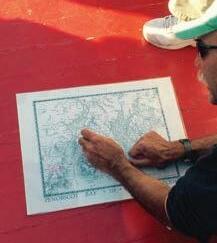
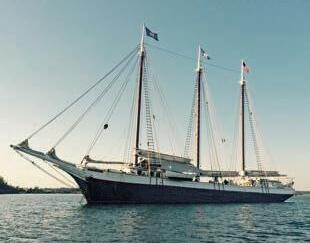




❂ ❂ 44 MarlinspikeMagazine.com
The historic three-masted windjammer Victory Chimes was sold at auction in May for $75,900. The high bidders were Miles and Alex Pincus, the brothers who have previously converted the schooners Pilot and Sherman Zwicker into restaurants for the New York market.
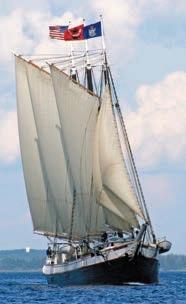


They also own the classic schooner yacht Coronet, currently undergoing restoration at Mystic Seaport.

The brothers said they did not have a concrete plan for the Chimes just yet, only that she would be leaving Maine.

“We’ve admired Victory Chimes for quite some time. When she went up for auction, we felt a responsibility to step in and ensure her preservation. We don’t have a plan yet other than to get her into safe harbor,” they said, in a statement shortly after the auction.

A spokesperson confirmed in June that there was still no concrete plan for the schooner.

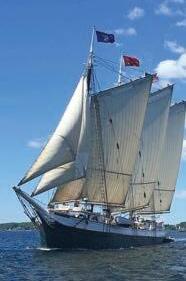

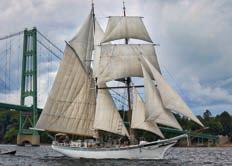

The 128’ Chimes was built in the Chesapeake back in 1900 as the Edwin & Maud. She has sailed the Maine coast since 1954. She has 21 cabins and can accommodate 43 passengers.
In 1987, Tom Monaghan, then owner of Domino’s Pizza and the Detroit Tigers, purchased the schooner and paid for an extensive restoration at the former Samples Shipyard in Boothbay. Just a few years later, Monaghan

MarlinspikeMagazine.com 45 MAINE WINDJAMMER CRUISES National landmarks Grace Bailey & Mercantile and specialty 6-passenger Mistress are joined by the luxury 6-passenger SWIFT. Well-appointed spacious cabins with private facilities. Full headroom below deck. Currently Seeking Captains & Crew for 2022 Sailing Season APPLY ONLINE AT MaineWindjammerCruises.com OR CALL 800-736-7981 New 2022!in The Swift ® s sold at auction Pincus brothers, state their plans mer windjammer
Key West is the opposite of a dry town. There are an infinite number of places to wet your whistle. Our favorite might be the Rum Bar on Simonton Street. For a small place, they have an astonishing collection of rum from all over, and bartenders who know their business.

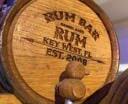

Here, my wife was introduced to the “Red Head” rum marketed by Sammy Hagar, reddish in color and (artificially) flavored with macademia nuts. Amazing addition to any rum-drink recipe! — MR
put the infrequently-used vessel (then called Domino Effect) up for sale.
One prospective buyer hoped to ship the schooner to Japan and convert it into a sushi restaurant. But Kip Files and Paul DeGaeta purchased her in 1990 and returned the renamed Victory Chimes to the Maine windjammer trade.
Sikkema purchased Chimes in 2018, but his plans for the vessel went awry, due in large part to COVID. This winter he purchased the Grace Bailey, formerly operated by Maine Windjammer Cruises, in partnership with Suzannah Smith and actor Marc Evan Jackson (The Good Place, Brooklyn Nine-Nine, Parks & Rec, The Baby-Sitters Club).
Proctor Academy announced this spring that its Ocean


Classroom program will henceforth be operated through Sea Education Association (SEA).
Since 1994, Proctor students have studied at sea as a part of the Ocean Classroom program. Throughout those nearly three decades, Proctor has worked with different partners, most recently Sailing Ships Maine.
SEA operates the steel-hulled brigantines Robert Seamans in the Pacific and Corwith Cramer in the Atlantic. The ships are equipped with oceanographic laboratories and hold “All Oceans” designations for operating.
Proctor’s program will mirror SEA’s college programs. Proctor students will spend an initial portion of the term at SEA’s Woods Hole campus. The ensuing voyage will see students sailing to Nova Scotia, Bermuda, Charleston, and back to Woods Hole, where they will finish research projects in preparation for a final symposium at Proctor.
“Ocean Classroom at SEA is a partnership that, in many ways, has been in the makings for decades,” SEA President John Wigglesworth said. “I am pleased that Proctor Academy and the Sea Education Association are now shipmates.”
Named a “Fenwick” after noted designer Fenwick Williams:

Take blueberry-pomegranate juice (not the sweetened cocktail version) mix with ginger ale or ginger beer and a shot of Pussers rum (Sailor Jerry’s a fair substitute) and serve over ice. Always give Ol’ Neptune a salute before drinking.

I have friends who sail with me just so they can get a Fenwick when we are back on the mooring.
— Jim Grenier
Boothbay Harbor Windjammer Days, slated for June 25-30, marks the kickoff to summer in the Boothbay region.
Launched in 1962, Windjammer Days has grown to a weeklong festival that includes the Grand Gathering of the Maine windjammer fleet to a golf tournament, road race, tug of war across the harbor, pirate duels, fireworks, tours of the Coast Guard Station, a lobstereating contest, codfish relay, haunted his-
★
★
46 MarlinspikeMagazine.com
A “Fenwick Williams” (made with ginger beer)
tory and maritime tours, rock skipping contest, and more.
Vessels offering public sails during the festival in include the schooners Alert, Tyrone, Eastwind, and Applejack as well as the Friendship sloop Bay Lady.
Visit the event website for a complete schedule of events and boat tours as well as a listing of the event’s lodging partners.
The Port of San Diego Board of Port Commissioners has voted to advance a redevelopment project proposed by the Maritime Museum Association of San Diego to the environmental review phase.
The Maritime Museum is seeking to redevelop its entire premises on the North Embarcadero with new facilities housed in a two-story, approximately 14,000-squarefoot structure with plans to include galleries, an educational theater, a café for ticketholders and the public, a museum store, public access terraces, a dock and dine for recreational boaters, administrative offices, and back-of-house functions.
“The Maritime Museum, with historic ships including the Star of India, San Salvador, ‘HMS’ Surprise, and others, is already an iconic cultural attraction on our San Diego Bay waterfront,” said Chairman Rafael Castellanos, Port of San Diego Board of Port Commissioners.
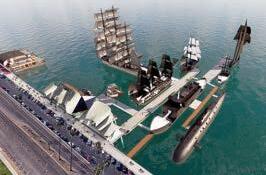
“If approved and constructed in the future, this project seeks to greatly enhance the area and bring even more people to our North Embarcadero where there are already so many fun and interesting things to see, do, and experience.”
At a meeting this spring, the Maritime Museum presented their proposed project to the Board of Port Commissioners. If ultimately approved, the expanded museum would be built on a pile-supported pier at the venue’s current location. In addition to the features described above, the Maritime Museum proposes to reconfigure the dock area and mooring locations of their current vessels to enhance the aesthetics of the operation from the vantage of the North Embarcadero, to safeguard the vessels from tide and weather events, and to create a more enticing venue to attract more visitors to the museum.
Inland Seas is planning a modest event in July to welcome their new schooner, Alliance, to the Great Lakes. The three-masted vessel was purchased in January but remained in the Chesapeake, having a variety of work done.

“While we are saving costs and time in the long run by completing these upgrades now, we find ourselves behind schedule for arriving in Suttons Bay by the June 24th date we had originally established,” says the ISEA website.
“Alliance is scheduled to conduct programming in Hessel, MI beginning on July 8th and the schooner Inland Seas will be conducting programs between Chicago and Detroit from the beginning of July until August 17th. To avoid disrupting our mission work, we are going to scale back our plans for a large event when Alliance arrives in Suttons Bay for the first time.
“Our current plan is for Alliance to go directly to Hessel to begin delivering programming on July 8th
MarlinspikeMagazine.com 47
★
★
ALERT is one of the schooners offering public sails during the Boothbay Harbor Windjammer Days festival June 25-30.
A rendering of what the Maritime Museum’s reconfigured docks might look like
then head to Charlevoix for programming. She will make her first trip into Suttons Bay on July 14th, where a smallerscale welcoming event will be held.
your dog in the Under The Sea Dog Parade, you’re going to love your day on Stamford’s thriving waterfront,” SoundWaters president Leigh Shemitz said.
ALLIANCE
“We hope you will be able to join us on July 14 to welcome Alliance into Grand Traverse Bay. We plan for her to arrive around 2:30 pm with dockside tours of the ship to follow from 3:00-6:00.” ★
SoundWaters HarborFest will take place on Saturday, August 27 from 10 am to 6 pm on the boardwalk at the Harbor Point Waterfront, 2200 Atlantic Street in Stamford, CT.
HarborFest is free to the public and there is free parking in the Harbor Point garages.
Hosted by SoundWaters, the Stamford-based environmental education and conservation organization, HarborFest “is fun, educational and free for everyone. Whether you tour the harbor on one of our boats or tour the oyster boat on the dock, enjoy the fresh oysters, play a round of golf or walk
The schedule of HarborFest activities is growing; visit SoundWatersHarborFest.org for the updated schedule. Planned events include $5 boat tours of Stamford Harbor and $5 Harbor Sails on the schooner SoundWaters
SALTS Sail and Life Training Society has been in the sail-training business for nealy 50 years, beginning in 1974 with the purchase of the Robertson II. The organization currently operates the schooners Pacific Grace and Pacific Grace from their Victoria, British Columbia base.
Almost ten years ago, SALTS announced an ambitious campaign to fund and build a new schooner, to be named Leonora, but this winter decided to finally cancel the project.

“As you may know, efforts to gain regulatory approval


Schooner RUTH
2014 steel schooner, Colvin design, 100’. Suitable for sail training or carrying cargo. Located Grenada. Asking $1,500,000. Contact Keith Chmura at Yachts New England (860) 303-7971
Schooner HALIE & MATTHEW
2006, fiberglass hull. Located Maine. COI for 100 on deck, 50 overnight. Asking $1,250,000.
Schooner AMAZING GRACE
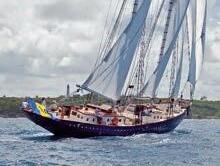
58’ LOD ferrocement schooner, built 1991. New engine, rigging, electronics. COI for Lakes Bays & Sounds, 33 + 2. Located San Juan, PR. Asking $450,000.
Schooner MERCANTILE
1916 wooden-hulled schooner in the Maine Windjammer trade. LOD 79', COI for 49, 29 overnight. New sails. Located Camden, ME. Reduced to $350,000. Contact Artisan Boatworks for full listing.
Friendship Sloop TUPELO HONEY
31’ Jarvis Newman sloop, fiberglass hull, 1981. Current COI for 17+2. Sale includes profitable Boston Harbor location. Asking $180,000. Contact Don Benoit at (617) 828-9250
Schooner CAPT. KIDD
55’ steel schooner, 2000. COI for 28. Located Seabrook, TX. Asking $190,000.
48
MarlinspikeMagazine.com
★
forRUTH
for a new ship have been ongoing for over a decade, and we recently had a breakthrough in this regard,” stated the organization’s fall newsletter.
“However, the myriad of design changes required to get through the regulatory hurdles, as well as inflation over the past decade, now put the cost estimate in the range of $8 million to $10 million. When we launched the project, our cost estimate was $3.5 million.
“Meanwhile, the pandemic has so far brought financial losses to SALTS in the range of $2 million, and our two existing schooners are in need of refits expected to cost in the range of $1 million.
“Taking all these factors and more into consideration, we believe that the new schooner is out of viable financial reach, and the time to make this call is before construction begins, so we don’t find ourselves with a half-built ship that we cannot afford to complete (or store and maintain).” ★
In early June, NOAA’s Climate Prediction Center announced the official beginning of “El Niño” conditions which are expected to gradually strengthen into the coming Northern Hemisphere winter.
El Niño usually brings a quieter Atlantic hurricane season and more hurricane activity in the Pacific. El Niño’s warmer waters can also push the Pacific jet stream south. When that happens, NOAA says, “areas in the northern U.S. and Canada are dryer and warmer than usual. But in the U.S. Gulf Coast and Southeast, these periods are wetter than usual and have increased flooding.”
“La Niña” conditions had “acted as a temporary brake

Manjack (also called Nunjack) Cay in the Abacos is in the cruiser-friendly Sea of Abaco, but north of Whale Cay and the sometimes raucous reef passage that divides the Sea into its quieter north and busier southern halves.

There was zero commercial activity on the Cay when we were there in December, apart from a faded sign advertising swimming pigs. There were also signs directing us to an “Art Walk” that featured dozens of handmade objets d’art created by cruisers over the years: everything from mannequins in foul-weather gear to painted conch shells, coconut-shell voodoo dolls, and fishing floats carved into fearsome masks.
The anchorage has good holding and decent protection from the north to the southeast. — MR
on global temperature increase” since late 2020.
But because of the new trend of warmer sea surface temperatures, the developing El Niño “will most likely lead to a new spike in global heating and increase the chance of breaking temperature records” that were only recently set.
★
This summer is your chance to see American artist Edward Hopper’s early works, painted on number of visits to Gloucester during the 1920s, when Hopper was already in his forties but still virtually unknown as a painter.
“Edward Hopper & Cape Ann: Illuminating an American Landscape” is on view at the Cape Ann Museum this summer beginning July 22. This exhibition offers a fresh look at one of America’s best-known artists at the crucial moment that profoundly shaped his art and his life. The success of Hopper’s Gloucester watercolors transformed his work in all media and set the stage for a monumental career.
This major exhibition of over 60 works includes an unprecedented loan from the Whitney Museum of American Art. The paintings include local fishing captains’ houses along with the then-new electrical and telephone wires, and fishing vessels in Gloucester Harbor.
The bonus in the show is the collection of Josephine N. Hopper’s paintings. Best known as his muse and model, she was a well-regarded painter in her own right, eventually subordinating her own career to his. The show hopes to help restore Jo N. Hopper to her rightful place as an artist. b
Do you have a newsworthy item for Boats, Bars & Beaches? Contact us at Marlinspike1812@gmail.com.
MarlinspikeMagazine.com 49
Artist and Scrimshander extraordinaire Alan Rogerson put ‘HMS’ Surprise on a bone-handled Myerchin. My first trip aloft underway was on Surprise, crewing for the Maritime Museum of San Diego. I love it, but it’s too pretty to use!
— Tadd Mannino
Top: “They’re just stainless fishermen’s lanyards from Amazon. Not as salty as a sennet or the like, but being aloft everyday, they’re way more practical for me.”
— Ryan Bradfield
Bottom: “I use the same lanyards. They are dirt cheap, strong and they stretch as far as my 6’ wingspan can reach. I don't leave the deck without them. The marlinspike was forged from a car spring and is the first one of about about two dozen that I have made over the years for shipmates. —
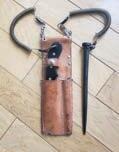
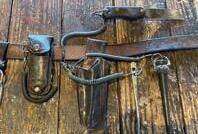 James Thayer
James Thayer
My uncle’s RN Broad Arrow marked 1988 Seaman’s Knife alongside my folding rigging knife with the lanyard I made. I picked up my knife at Longship Marine in Poulsbo, WA.

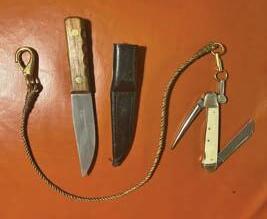 — Mark Smith
— Mark Smith
54 MarlinspikeMagazine.com
#coastguard #barque #eagle Four summers. Twice as a cadet, twice as an officer. Qualified as underway officer of the deck my final ride.
— Craig Swirbliss
All except the anchor were done by the same artist, Cello from Valor Tattoo 5-Points in Levittown, PA. The swallows are from 5000 nm sea time each. I got the wheel to symbolize when I upgraded to a Mate of Towing license, and the mermaid is a pinup girl in honor of my wife and her dealing with my love of the sea, ha ha. I will be completely honest, the anchor was done at a shop I can’t remember in Jersey City after a long night of shore leave.

 — Kyle Silva
— Kyle Silva
North Star, to guide me home. Blue and yellow to reflect my ship, the Kalmar Nyckel. I’m a newly minted crew member. Trained over the winter and I’m actually currently sitting on the boat doing daysails. Tommy Yetter at Tattoo Galaxy in Rehoboth did it for me, from a Sailor Jerry flash.
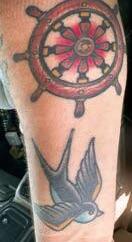

 —
—
Will Horning MarlinspikeMagazine.com
55

















 — Maggie Ostler
— Maggie Ostler












 Photo by George Bekris
Photo by George Bekris













 — Noah Waldman
— Noah Waldman















 PHOTO: A+ WORLD ACADEMY
PHOTO: A+ WORLD ACADEMY































































 James Thayer
James Thayer

 — Mark Smith
— Mark Smith

 — Kyle Silva
— Kyle Silva


 —
—